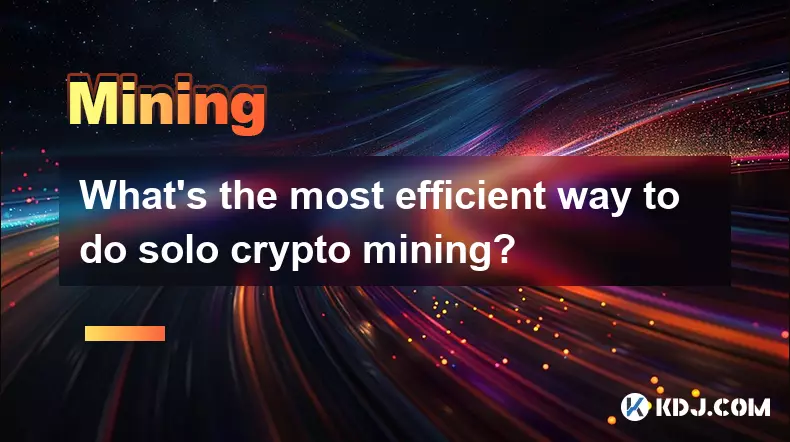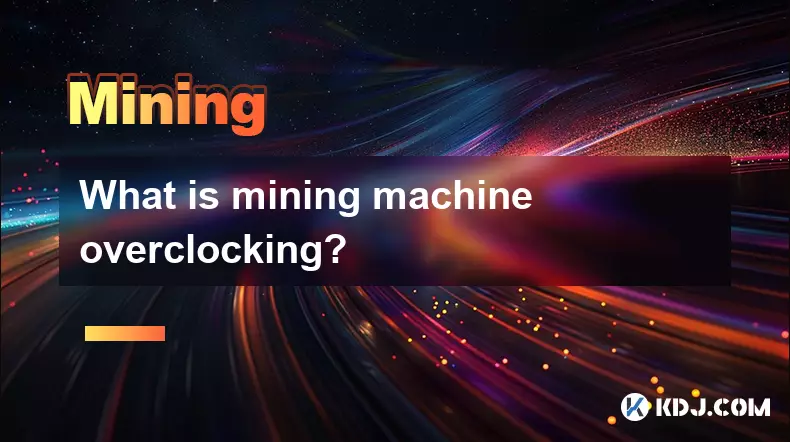-
 bitcoin
bitcoin $109523.663807 USD
-0.13% -
 ethereum
ethereum $4019.526508 USD
2.06% -
 tether
tether $1.000482 USD
0.00% -
 xrp
xrp $2.776815 USD
0.18% -
 bnb
bnb $958.942396 USD
0.12% -
 solana
solana $204.294698 USD
3.84% -
 usd-coin
usd-coin $0.999693 USD
0.00% -
 dogecoin
dogecoin $0.232115 USD
2.09% -
 tron
tron $0.338028 USD
0.84% -
 cardano
cardano $0.790920 USD
1.50% -
 hyperliquid
hyperliquid $44.871443 USD
5.60% -
 ethena-usde
ethena-usde $1.000322 USD
0.04% -
 chainlink
chainlink $21.034165 USD
2.60% -
 avalanche
avalanche $28.794831 USD
-0.54% -
 stellar
stellar $0.360466 USD
1.24%
What's the most efficient way to do solo crypto mining?
Solo crypto mining efficiency hinges on hardware, network difficulty, and low electricity costs, with success favoring high-hash-rate setups and optimal configuration.
Sep 04, 2025 at 12:36 am

Understanding Solo Crypto Mining Efficiency
1. Solo mining refers to the process of validating blockchain transactions without joining a mining pool. Miners who operate independently must solve cryptographic puzzles using their computational power to earn block rewards. The efficiency of this method depends heavily on hardware capabilities, network difficulty, and electricity costs. High-performance ASICs or GPUs are essential for staying competitive, especially on networks like Bitcoin or Ethereum Classic.
2. Network hash rate plays a crucial role in determining how often a solo miner might find a block. On blockchains with high global hash rates, the probability of an individual miner solving a block drops significantly. This makes efficiency less about raw speed and more about sustained operation under optimal conditions.
3. Energy consumption must be minimized to maintain profitability. Mining rigs generate substantial heat and consume large amounts of power. Locations with low electricity rates and natural cooling advantages provide a structural edge. Overclocking hardware can increase output but may shorten device lifespan and raise cooling demands.
4. Mining software should be optimized for the specific hardware and cryptocurrency. Tools like CGMiner, BFGMiner, or PhoenixMiner allow fine-tuning of intensity, fan speeds, and voltage. Proper configuration reduces idle cycles and maximizes hash output per watt.
Hardware Selection and Optimization
1. ASIC miners dominate Bitcoin mining due to their superior efficiency compared to GPUs. For algorithms like SHA-256, devices such as the Antminer S19 series deliver high hash rates with relatively low power draw per terahash. Selecting the latest generation models ensures better performance and energy efficiency.
2. GPU mining remains viable for coins using Ethash, KawPow, or similar algorithms. High-end graphics cards like the NVIDIA RTX 4090 or AMD RX 7900 XTX offer strong performance. Multi-GPU setups require motherboards with sufficient PCIe lanes and robust power supplies to avoid bottlenecks.
3. Regular maintenance improves longevity and efficiency. Dust accumulation reduces airflow and increases operating temperatures. Cleaning components every few weeks and monitoring thermal throttling helps maintain peak performance.
4. Undervolting and tuning can boost efficiency without sacrificing much hash rate. By reducing voltage while maintaining stable operation, miners decrease power draw and heat output. This adjustment often leads to higher net profitability over time.
Choosing the Right Cryptocurrency
1. Not all cryptocurrencies are suitable for solo mining. Coins with lower network difficulty increase the chances of finding a block. Examples include Bitcoin Gold (BTG), Ravencoin (RVN), or Monacoin (MONA), which are designed to resist ASIC dominance and favor GPU miners.
2. Block frequency affects reward consistency. Networks with shorter block times offer more frequent opportunities to earn, even if individual rewards are smaller. This can stabilize income for solo miners who might otherwise face long dry spells.
3. Transaction fees contribute to total revenue. Some blockchains accumulate significant fees during periods of high demand. Solo miners benefit fully from these fees when they find a block, unlike pool miners who share them.
4. Decentralization goals align with solo mining principles. Cryptocurrencies that value distributed mining power often implement ASIC-resistant algorithms, creating a more level playing field for individual operators.
Network and Software Configuration
1. A stable, low-latency internet connection is critical. Delays in receiving new block headers can result in wasted computation. Wired Ethernet connections are preferred over Wi-Fi to minimize packet loss and jitter.
2. Running a full node enhances reliability. By maintaining a complete copy of the blockchain, solo miners validate transactions independently and reduce dependency on third-party servers. This setup also improves security and data integrity.
3. Mining software must connect directly to the blockchain network. Configuration files should point to official nodes or trusted peers. Avoiding intermediaries reduces the risk of man-in-the-middle attacks or delayed updates.
4. Monitoring tools track uptime, rejected shares, and temperature fluctuations. Real-time alerts help identify issues before they lead to downtime. Automation scripts can restart processes or adjust settings based on system behavior.
Frequently Asked Questions
What is the biggest risk of solo mining?The primary risk is unpredictability in block discovery. A solo miner might go weeks or months without finding a block, leading to extended periods with no income despite ongoing electricity and hardware costs.
Can I solo mine Bitcoin with a home setup?Technically possible, but highly impractical due to the immense network difficulty. A single ASIC might take years to find a Bitcoin block alone. Most home miners achieve better results through pools or by targeting less competitive coins.
Does solo mining require more technical knowledge than pool mining?Yes. Solo mining demands deeper understanding of blockchain mechanics, networking, and system optimization. Configuring a node, managing firewall rules, and troubleshooting sync issues are common tasks.
Are there tax implications specific to solo mining?Income from solo mining is typically treated as taxable event upon block reward receipt. Record-keeping for hardware depreciation, electricity costs, and market value at time of receipt is essential for accurate reporting.
Disclaimer:info@kdj.com
The information provided is not trading advice. kdj.com does not assume any responsibility for any investments made based on the information provided in this article. Cryptocurrencies are highly volatile and it is highly recommended that you invest with caution after thorough research!
If you believe that the content used on this website infringes your copyright, please contact us immediately (info@kdj.com) and we will delete it promptly.
- Whales, Trump Coin, and Crypto: A New York Minute on What's Hot (and What's Not)
- 2025-09-27 10:25:17
- SWIFT Tests On-Chain Messaging with Linea: A New Era for Global Finance?
- 2025-09-27 10:25:17
- BullZilla Crypto Presale: Surging Through the Meme Coin Jungle
- 2025-09-27 11:05:15
- Binance Coin, WLFI, Crypto Presales: Decoding 2025's Hottest Trends
- 2025-09-27 10:45:15
- Bitcoin, Gold, Stocks: Navigating the Shifting Sands of Investment in 2025
- 2025-09-27 11:05:15
- Bitcoin, Cardano, and Crypto Presales: Is BullZilla the Next Big Thing?
- 2025-09-27 11:10:01
Related knowledge

The difference between staking and mining
Sep 24,2025 at 05:18am
Understanding Staking in the Cryptocurrency Ecosystem1. Staking involves holding funds in a cryptocurrency wallet to support the operations of a block...

How to participate in testnet mining?
Sep 22,2025 at 09:18am
Understanding Testnet Mining in the Crypto Ecosystem1. Testnet mining is a method used by blockchain developers to simulate real-world conditions on a...

How to dispose of abandoned mining machines?
Sep 19,2025 at 08:19pm
Assessing the Condition of Abandoned Mining Rigs1. Begin by inspecting each mining machine for visible damage, corrosion, or missing components. Machi...

How to identify high-quality mining pools?
Sep 21,2025 at 03:19pm
Reputation and Track Record1. A mining pool’s reputation is built over time through consistent performance and transparency. Pools that have operated ...

Advantages of decentralized mining pools
Sep 20,2025 at 04:36pm
Enhanced Security and Resistance to Censorship1. Decentralized mining pools operate on blockchain-based smart contracts, eliminating the need for a ce...

What is mining machine overclocking?
Sep 21,2025 at 07:19pm
Understanding Mining Machine Overclocking1. Mining machine overclocking refers to the process of increasing the operating frequency of a cryptocurrenc...

The difference between staking and mining
Sep 24,2025 at 05:18am
Understanding Staking in the Cryptocurrency Ecosystem1. Staking involves holding funds in a cryptocurrency wallet to support the operations of a block...

How to participate in testnet mining?
Sep 22,2025 at 09:18am
Understanding Testnet Mining in the Crypto Ecosystem1. Testnet mining is a method used by blockchain developers to simulate real-world conditions on a...

How to dispose of abandoned mining machines?
Sep 19,2025 at 08:19pm
Assessing the Condition of Abandoned Mining Rigs1. Begin by inspecting each mining machine for visible damage, corrosion, or missing components. Machi...

How to identify high-quality mining pools?
Sep 21,2025 at 03:19pm
Reputation and Track Record1. A mining pool’s reputation is built over time through consistent performance and transparency. Pools that have operated ...

Advantages of decentralized mining pools
Sep 20,2025 at 04:36pm
Enhanced Security and Resistance to Censorship1. Decentralized mining pools operate on blockchain-based smart contracts, eliminating the need for a ce...

What is mining machine overclocking?
Sep 21,2025 at 07:19pm
Understanding Mining Machine Overclocking1. Mining machine overclocking refers to the process of increasing the operating frequency of a cryptocurrenc...
See all articles










































































